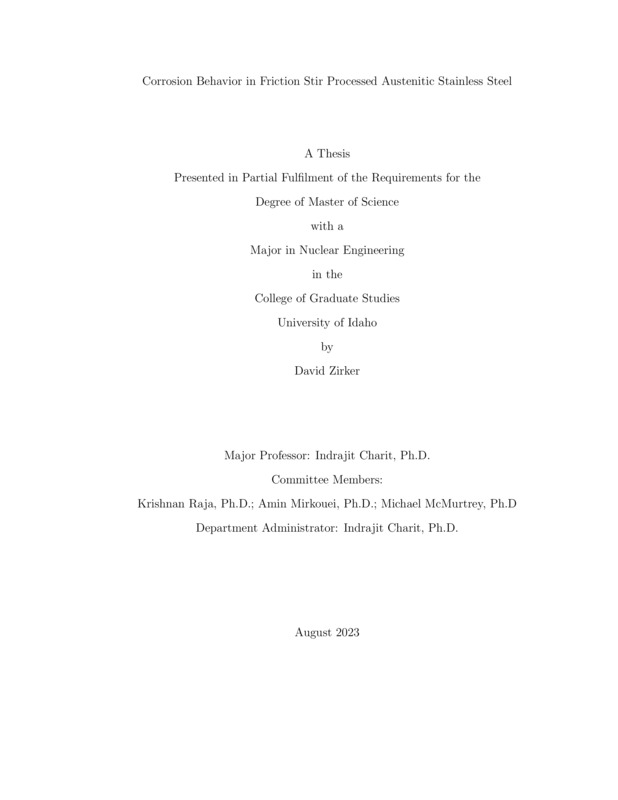Corrosion Behavior in Friction Stir Processed Austenitic Stainless Steel
Zirker, David Laurence. (2023-08). Corrosion Behavior in Friction Stir Processed Austenitic Stainless Steel. Theses and Dissertations Collection, University of Idaho Library Digital Collections. https://www.lib.uidaho.edu/digital/etd/items/zirker_idaho_0089n_12695.html
- Title:
- Corrosion Behavior in Friction Stir Processed Austenitic Stainless Steel
- Author:
- Zirker, David Laurence
- Date:
- 2023-08
- Keywords:
- chloride induced stress corrosion cracking Corrosion Friction stir processed stainless steel
- Program:
- Nuclear Engr & Industrial Mgmt
- Subject Category:
- Nuclear engineering
- Abstract:
-
Chloride induced stress corrosion cracking (CISCC) is particularly deleterious to 300series stainless steels. Examples of CISCC have been reported on the surfaces of Type 304, 304L, and 316L stainless steel components in a variety of environments where chloride is present. Localized pitting generally precedes CISCC, and therefore improving the pitting resistance of a material generally improves resistance to CISCC. Friction stir processing is a proposed technique to repair and mitigate material chloride induced stress cracks by adding molybdenum to the base material. Molybdenum improves pitting resistance and that is why it is used in this experiment. Friction stir processed samples were made by adding 316L and molybdenum powder to 304L stainless steel via friction stir processing. By using electrochemical techniques, an evaluation of the friction stir processed samples was performed to evaluate corrosion resistant qualities of the material. Cyclic polarization results suggests that the addition of the molybdenum through FSP was not beneficial to pitting resistance of the samples. The FSP 304L sample had a pitting potential around 0.3342 V where as the FSP 304L+Mo sample only had a pitting potential of around 0.2872 V. Friction stir processing was beneficial in decreasing the corrosion current and in the case of the FSP 304L+Mo increasing the linear polarization significantly. U-bend samples were also made and tested in an open circuit potential and a 0.2 V static potential. The FSP 304L+316L and FSP 304L+Mo were more noble than the 304L in the open circuit potential analysis and did not fail in the u-bend test yet the surface crack density was higher in the FSP samples. The expirement was terminated at 2472 hours and the FSP 304L+316L and FSP 304L+Mo were removed from the 2.5 M sulfuric acid + 0.5 M sodium chloride solution with no failure. By contrast, the 304L base u-bend sample had a low surface crack density yet failed at 267.5 hours. The potentiostatic analysis revealed that the FSP 304L+Mo sample had improved passivation kinetics.
- Description:
- masters, M.Engr., Nuclear Engr & Industrial Mgmt -- University of Idaho - College of Graduate Studies, 2023-08
- Major Professor:
- Charit, Indrajit
- Committee:
- Mirkouei, Amin; Raja, Krishnan; McMurtrey, Michael
- Defense Date:
- 2023-08
- Identifier:
- Zirker_idaho_0089N_12695
- Type:
- Text
- Format Original:
- Format:
- application/pdf
- Rights:
- In Copyright - Educational Use Permitted. For more information, please contact University of Idaho Library Special Collections and Archives Department at libspec@uidaho.edu.
- Standardized Rights:
- http://rightsstatements.org/vocab/InC-EDU/1.0/

